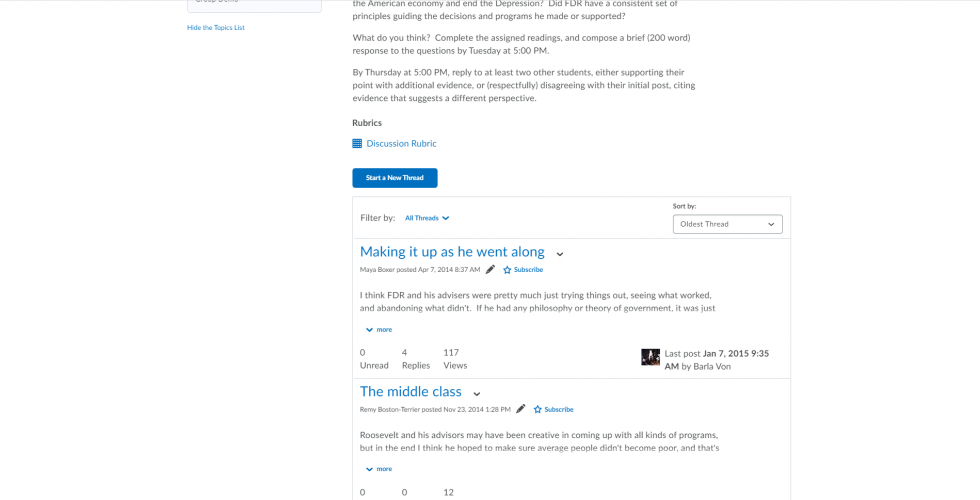Many faculty use asynchronous or message-board discussions in their courses. These are usually in the D2L discussions space and toolset, but Hypothes.is discussions may qualify as asynchronous discussions, too.
Either way, you can achieve a much greater presence and influence in your students’ perception of the course by participating in these discussions. Often, instructors build discussions around great prompts, set deadlines for student participation, and then do not add anything to the discussions. Professors may worry that if they did, they would be intruding on a space for students. Or, they might get in the way of a student making a similar comment or insight. Other instructors may just feel that it is too much effort, on top of other instructor responsibilities.
But there are several relatively low-effort ways you can contribute to discussions, so that they are richer and more instructive for students. Your contribution might transform an asynchronous discussion from a writing assignment to an actual conversation.
Here are some suggested instructor posts or replies to asynchronous discussions:
Model Post
Early on in a semester write a discussion post that represents a high-quality contribution to an asynchronous discussion. Message board participation requirements can vary widely from course to course, so your model post helps students know what your particular requirements are for this activity.
Steer a Thread Back on Track
If a discussion generates enthusiasm, students may veer off topic. You may tolerate that, if it satisfies learning objectives. For example, as a historian, I want students to analyze sources. If three students turn to critically discussing a source they read for another class, I may permit it despite their having drifted from the source I assigned that week.
On the other hand, off-topic conversation can be time-consuming and counterproductive. A well-placed follow up question by the professor might get students back to the topic at hand. For example: “The use of shipping containers by militaries is interesting but returning to the article, what are the business implications of container-freight for the Suez, Panama, Kiel and Corinth canals?”
Encourage a Student to Say More
Occasionally students simply do not say enough, or are vague. You may not be sure of the point they are making. Or, you may or may not sense that they didn’t do the weekly reading. Either way, you can give a student a second opportunity to respond in greater depth or detail, and your prompt for this indirectly illustrates your requirements to the other students as well.
For example: “I think your comment refers to Dom’s insistence on discipline, but what do you think he means by discipline, specifically as it relates to his Jewish partisan comrades?”
Highlight an Excellent Contribution
Occasionally a student writes the perfect post that meets the assignment requirements exactly. Point it out! This helps this student know they are on track, and others to see what you want them to do. You might also link it to something else in the course, or in the wider discipline, just to emphasize the importance of good work.
Example: “This is a great observation concerning bankruptcies, because you’ve highlighted exactly why infrastructure receiverships can be so expensive and time-consuming. Years ago I researched Pittsburgh Railways Company’s bankruptcy in the mid-Twentieth Century. It took twelve years! While accounting is much quicker now, the legal back-and-forth can still last years.”
Correct a Falsehood
You might read where a student is, to be plain, wrong about something. They are in the process of learning and appropriately you can reply with a correction, for their and their classmates’ benefit. Obviously, consider how to do this with tact and constructive grace.
A student may make an incorrect generalization beyond the course content, but if they missed something available in course content, direct them to revisit it.
For Example: “The term ‘nun’ is not directly synonymous with ‘sister’ in the Catholic faith tradition. But the two terms are commonly, if not accurately, used interchangeably in everyday conversation and even a lot of Catholics are not aware of the distinction. Take a look at the article by Van Eindhoven, that we read back in Week 3; how are nuns set apart from other orders of Catholic sisters?”
Reply Selectively
Do not attempt to reply to teach students in each asynchronous discussion. You probably cannot (or should not) spare that kind of time. Moreover, you may find that you are stepping in front of students who might ask constructive questions of each other. You might choose one or two posts a week, for which one of the above reply options works best. This is more than enough to establish a supportive instructor presence in the class, without becoming a distraction.
Share this:
- Click to share on Twitter (Opens in new window)
- Click to share on Facebook (Opens in new window)
- Click to share on LinkedIn (Opens in new window)
Submitted by: Tyler J. Kron-Piatek, academic technologist, COLI

